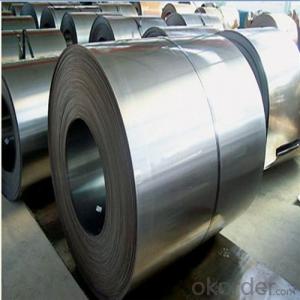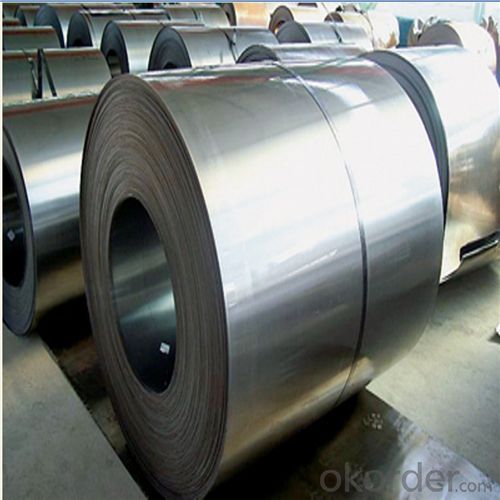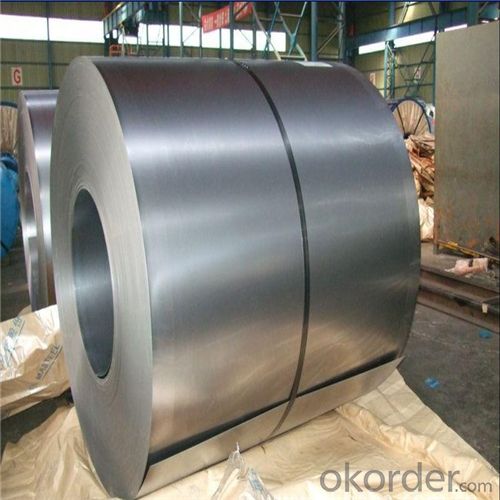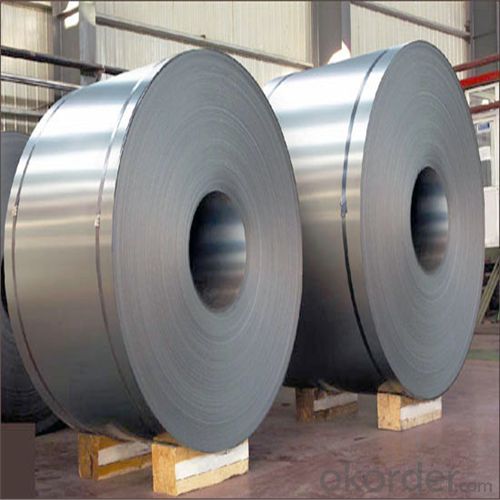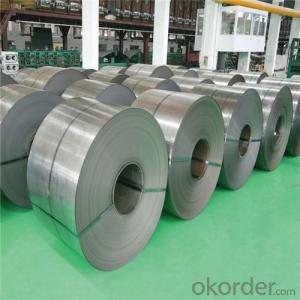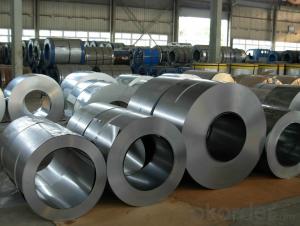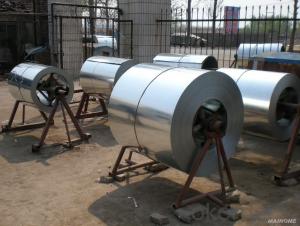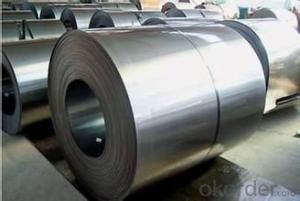Cold Rolled Steel Coil Used for Industry with Too Kind Price
- Loading Port:
- Tianjin
- Payment Terms:
- TT OR LC
- Min Order Qty:
- 25 m.t.
- Supply Capability:
- 8000 m.t./month
OKorder Service Pledge
OKorder Financial Service
You Might Also Like
Pure Cold Rolled Steel Coil Used for Industry
1.Structure of Cold Rolled Steel Coil Description
The thin gauge cold rolled steel sheet and strip steel have advantages of low surface roughness, high dimension accuracy and good mechanical properties etc, and which have been widely used in auto manufacturing, home appliance, architecture, aviation, precision instrument, hardware and enameling industry etc.
2.Main Features of the Cold Rolled Steel Coil
•High Purity
•Easy control and operation
•High strength
•Fast melting
•Competitive price
•Best Service
3. Cold Rolled Steel Coil Images

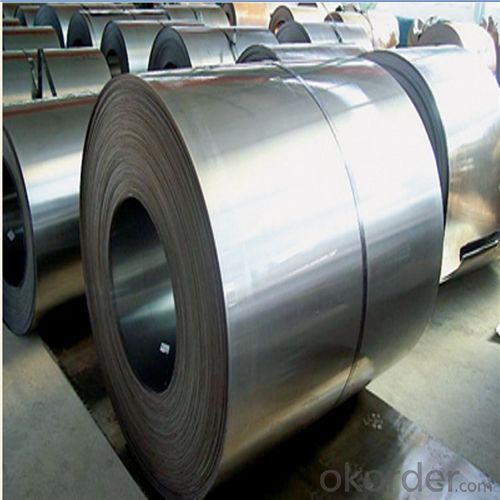

4. Cold Rolled Steel Coil Specification
COLD ROLLED STEEL COIL | |
Thicknenss | 0.10mm-4.00mm |
Width | 600mm-2000mm |
Sheets length | 1200-6000mm |
Coil inner diameter | 508-610mm |
Surface treatement | matt finish/bright finish,oiling/dry, bright anneal/black anneal |
Coil weight | 3-5t |
5.FAQ of Cold Rolled Steel Coil
We have organized several common questions for our clients,may help you sincerely:
①How about your company?
Annually more than 8000 tons Precision casting and forging parts are exported to markets in Europe,America and Japan. OEM casting and forging service available according to customer’s requirements.
②How to guarantee the quality of the products?
We resolutely put an end to unqualified products flowing into the market. At the same time, we will provide necessary follow-up service assurance.
③How long can we receive the product after purchase?
In the purchase of product within three working days, We will arrange the factory delivery as soon as possible. The pecific time of receiving is related to the state and position of customers.Commonly 7 to 10 working days can be served.
- Q: What are the different types of steel coil surface coatings?
- There are several different types of steel coil surface coatings that are used to enhance the durability, corrosion resistance, and aesthetic appearance of the steel. Some of the commonly used coatings include: 1. Zinc Coatings: Zinc coatings are widely used to protect steel from corrosion. Galvanized steel coils are coated with a layer of zinc to provide a barrier against moisture and other environmental elements. 2. Galvannealed Coatings: Galvannealed coatings are a combination of zinc and iron. This coating provides enhanced corrosion resistance and also improves paint adhesion, making it suitable for applications where painting is required. 3. Aluminum Coatings: Aluminum coatings are used to provide a lightweight and corrosion-resistant surface. Aluminum-coated steel coils are often used in the automotive industry for body panels and other parts that require high strength and resistance to corrosion. 4. Organic Coatings: Organic coatings are typically applied as a layer of paint or powder coating. These coatings provide protection against corrosion and also offer a wide range of color options for aesthetic purposes. They are commonly used in the construction industry for roofing and cladding applications. 5. Metallic Coatings: Metallic coatings such as tin, nickel, and chromium can be applied to steel coils to provide specific properties like improved electrical conductivity, increased hardness, or enhanced resistance to wear and tear. 6. Ceramic Coatings: Ceramic coatings are used to provide high-temperature resistance and thermal barrier properties. They are often used in applications where steel coils are exposed to extreme heat or in industrial processes that require thermal insulation. Each type of coating has its own unique properties and advantages, and the choice of coating depends on the specific requirements of the application. Manufacturers and engineers carefully consider factors such as cost, durability, corrosion resistance, and aesthetic appeal when selecting the appropriate coating for steel coils.
- Q: Is condensation on steel caused from water being pulled out or is the condensation formed from the air around the steel object?
- Steel contains no water; any water that you see is condensed out of the air.
- Q: I installed it, added it in F3 launcher and then after one minute of walking in wasteland I get a signal that Broken steel was added and that my level of caps was raised by 30. However after this message no quest is added. I played all 4 exp. packs and I had no problem at all, each time a new quest was added. So whats up with this Broken steel. Btw, I completed the entire game F3.
- Broken Steel's quests activate once you have beaten the final mission in the purifier. If you have already beaten the game, then you should just go back to the purifier and beat it again, since normally you wouldn't be able to continue to play the game once you have beaten it without Broken Steel. If you were able to continue playing the game, then it's likely that whatever mod you used is interacting with the game and making it impossible for Broken Steel to activate.
- Q: What are the properties of high-strength steel coils?
- High-strength steel coils possess a range of unique characteristics that make them highly sought-after in diverse industrial applications. Firstly, these coils demonstrate extraordinary strength, enabling them to withstand substantial force or weight without deformation or breakage. This quality renders them suitable for demanding environments and heavy-duty purposes. Another noteworthy property of high-strength steel coils is their exceptional resistance to wear and tear. They exhibit a high level of hardness, allowing them to endure abrasion, impact, and other forms of mechanical stress. Consequently, they prove ideal for applications where durability and longevity are paramount, such as construction, automotive manufacturing, and machinery production. Furthermore, high-strength steel coils frequently exhibit remarkable corrosion resistance. They are typically coated or treated with protective materials to prevent rust or other types of deterioration caused by exposure to moisture, chemicals, or harsh environmental conditions. This corrosion resistance ensures the durability and reliability of the coils, making them well-suited for use in marine environments or outdoor structures. Additionally, high-strength steel coils offer excellent formability, meaning they can be easily shaped or bent without compromising their strength or integrity. This characteristic empowers manufacturers to create intricate or customized shapes for specific applications, enhancing the versatility and adaptability of the coils. Lastly, high-strength steel coils are renowned for their lightweight nature compared to other materials possessing similar strength properties. This low weight-to-strength ratio positions them as the preferred choice in industries that prioritize weight reduction, such as aerospace or automotive manufacturing. It facilitates improved fuel efficiency, increased payload capacity, and overall cost savings. In conclusion, high-strength steel coils possess exceptional strength, resistance to wear and tear, corrosion resistance, formability, and lightweight characteristics, rendering them invaluable and versatile materials in a wide array of industries.
- Q: How are steel coils processed for edge trimming or conditioning?
- Steel coils are processed for edge trimming or conditioning through a series of mechanical and/or thermal methods. The coils are first uncoiled and then passed through a slitting machine to cut them into narrower strips. The edges of these strips are then trimmed to remove any irregularities or excess material. This can be done through shearing, grinding, or milling processes. Once the edges are trimmed, the coils may undergo further conditioning processes like straightening, leveling, or rewinding to ensure they meet the required specifications.
- Q: How do steel coils contribute to sustainability in construction?
- Steel coils contribute to sustainability in construction in several ways. Firstly, steel is a highly durable and long-lasting material, which means that structures built using steel coils have a longer lifespan and require fewer repairs and replacements. This reduces the overall environmental impact associated with construction activities. Additionally, steel is a highly recyclable material, with most steel coils containing a significant amount of recycled content. This promotes a circular economy and reduces the demand for new raw materials. Moreover, steel coils are lightweight and versatile, allowing for more efficient transportation and installation, thereby reducing energy consumption and emissions during construction. Overall, the use of steel coils in construction promotes sustainability by offering durability, recyclability, and energy efficiency.
- Q: Can steel coils be coated with anti-corrosive substances?
- Yes, steel coils can be coated with anti-corrosive substances. Coating the coils with anti-corrosive substances provides an additional layer of protection, preventing or slowing down the process of corrosion and extending the lifespan of the steel coils.
- Q: What are the factors to consider when selecting a supplier for steel coils?
- When selecting a supplier for steel coils, there are a few key factors to consider. Firstly, the quality of the steel coils is crucial. It is important to assess the supplier's reputation, certifications, and track record for delivering high-quality products. Secondly, pricing and cost-effectiveness play a significant role. Comparing prices and negotiating favorable terms with different suppliers is essential to ensure competitive pricing. Additionally, the supplier's reliability and ability to meet delivery schedules must be thoroughly evaluated. Timely delivery is vital to avoid disruptions in production. Lastly, considering the supplier's location, proximity to the manufacturing facility, and their overall customer service and support are also important factors to take into account.
- Q: What is the process for uncoiling and recoiling steel coils?
- The process for uncoiling and recoiling steel coils involves several steps to ensure the safe and efficient handling of the coils. 1. Unloading: The steel coils are typically transported to the desired location using cranes or forklifts. They are carefully unloaded from the transportation vehicle and placed in a designated area. 2. Inspection: Before uncoiling, it is crucial to inspect the steel coils for any damage or defects. This step ensures that only quality coils are processed further. 3. Securing: Once inspected, the steel coils are secured to prevent any movement during the uncoiling process. This is done by using clamps or straps to hold the coils firmly in place. 4. Uncoiling: Uncoiling involves the gradual unwinding of the steel coil. This can be done manually or using specialized machinery such as uncoilers or decoilers. The coil is typically fed through a series of rollers that help guide the unwinding process. 5. Straightening: In some cases, the steel coil may need to be straightened before further processing. This can be done using straightening machines that apply pressure to remove any bends or twists in the steel. 6. Cutting: If required, the uncoiled steel coil may be cut into smaller sections or sheets. This can be done using shearing machines or other cutting tools. The dimensions and size of the cuts depend on the specific requirements of the project. 7. Recoiling: Once the desired processing steps are completed, the steel coil can be recoiled. This involves rewinding the steel into a new coil shape. Recoiling can be done manually or using recoilers, which wind the steel evenly and tightly to maintain its integrity. 8. Packaging and storage: After recoiling, the steel coils are typically packaged and stored for further transportation or use. They may be wrapped in protective materials such as plastic or metal sheets to prevent corrosion or damage. Overall, the process for uncoiling and recoiling steel coils requires careful handling, inspection, and the use of specialized machinery. By following these steps, steel coils can be efficiently processed and prepared for various applications in industries such as construction, automotive, and manufacturing.
- Q: okay i got some questions of the steel plow.1st - who inveneted it? where and when?2nd - how did it work? what is it used for? what is it made of? how is it produced?okay guys thank you very much. remember best answer gets best answer 10 points!
- You want ot read up on American John Deere; he madethe first plow capable of cutting the virgin sod of the great planes.
Send your message to us
Cold Rolled Steel Coil Used for Industry with Too Kind Price
- Loading Port:
- Tianjin
- Payment Terms:
- TT OR LC
- Min Order Qty:
- 25 m.t.
- Supply Capability:
- 8000 m.t./month
OKorder Service Pledge
OKorder Financial Service
Similar products
Hot products
Hot Searches
Related keywords
